Mycotoxins are toxic metabolites produced by different species of fungi found in many crops, posing a risk to animals and humans alike.
They have negative effects on:
According to the WHO, approximately 25% of world crops are affected by mycotoxins, which represents a risk to animal and public health, as well as economic losses. Strategies are available to prevent the appearance of fungi, but once they have been detected in raw materials or in feed, it is very likely that mycotoxins have already appeared, and it is then practically unfeasible to destroy or eliminate them on a large scale with chemical or thermal treatments.
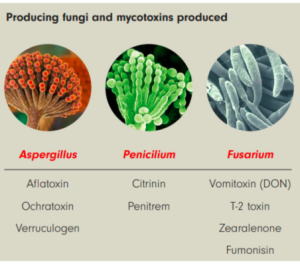
Even if a fungicidal treatment has been started, and bearing in mind that it is not possible to analyse mycotoxins in all the samples that arrive as raw materials (currently over 300 types of mycotoxins have been identified), the strategy to choose from that point is to prevent the possibility of introducing these toxins into the food chain, preventing animals that ingest them from absorbing them in their metabolism.
At present, the primary agents used for mycotoxin detoxification are:
These are feed additives that suppress or reduce absorption, promote the excretion of mycotoxins or modify the way they act, thereby mitigating the possible harmful effects of mycotoxins on animal health.
Binders act by exerting a physical or polar attraction on mycotoxins which are adsorbed and then excreted along with the adsorbent, while biotransformers (bacteria or enzymes) modify the structure of the mycotoxin making it less toxic or harmless.
These strategies are insufficient by themselves, since the structures of mycotoxins are very diverse and we will therefore not find one pathway that is efficient against all of them by itself.
At dex we have designed an adsorbent based on natural aluminosilicates and yeast cell walls. It is completely harmless and indigestible, meaning that it is excreted retaining the mycotoxins without affecting the nutritional value of the feed and prevents these toxins from passing into the animal’s bloodstream.
Mechanisms of Action of toxidex® primus
It works using four different mechanisms (two pathways acting against mycotoxins and two pathways acting as a boost for the animal) that together produce a synergistic effect that completely protects the animal.
1st Mechanism
The first mechanism takes place in the digestive system and consists of the adsorption of mycotoxins within the laminar structure of the aluminosilicate.
toxidex primus® differs from other adsorbent products in that it is a studied combination of three different aluminosilicates, complementing their action spectra and therefore adsorbing most mycotoxins.
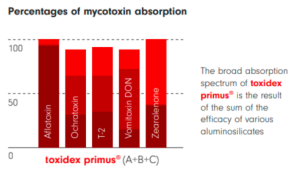
This adsorption takes place thanks to steric capture and the chemical and polar affinity that occurs between networks of adsorbents and mycotoxins.
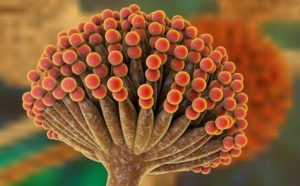
Furthermore, this mechanism is improved thanks to the addition of various technological additives that act as surfactants and increase the contact surface between the less polar mycotoxins and adsorbent networks.
2nd Mechanism
A second mechanism (destructive complex) complements the protective action of adsorption. This consists of the activation of the aluminosilicates with a form of ammonium, which has been shown to reduce the toxicity and mutagenicity of some mycotoxins, and is the chemical method of detoxification with the most potential in terms of both economics and safety.
With this form of action, toxidex primus® combines the adsorption of mycotoxins with a transformation or destruction mechanism; this completely protects the animal, as the mycotoxins that have not been adsorbed are transformed into non-toxic or less toxic metabolites, thereby mitigating the negative effects of them being absorbed through the intestinal wall..
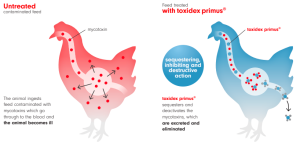
3rd Mechanism
The third mechanism converts toxidex primus® into a product that goes beyond conventional sequestrants, with a protective and metabolism boosting effect.
When an animal ingests a feed contaminated with toxins, the animal’s own detoxifying system comes into action; this takes place in the blood or liver and the aim is to eliminate toxins that have managed to cross the intestinal barrier.
As a means of prevention, and in the event that the animal has already been poisoned by the toxin, toxidex primus® is used as a metabolic booster.
This boost consists of enhancing the biotransformation and detoxifying action of glutathione S-transferase.
This enzyme, found in the animal’s habitual metabolism, should be enhanced when there is poisoning or a severe oxidative attack.
Glutathione is made up of three amino acids; as such, we use different precursor molecules of the complex and cofactors in order to achieve an increase in activity by glutathione S-transferase, eliminating mycotoxins through the excretion of the glutathione-mycotoxin complex.
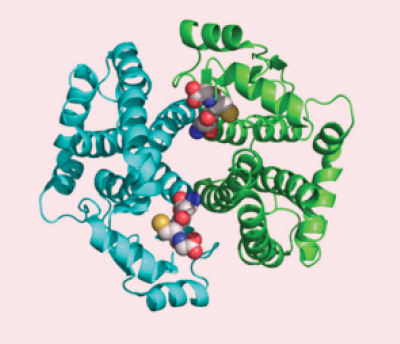
4th Mechanism
As well as exerting a toxic action on the animal, mycotoxins also damage its immune system.
Therefore, toxidex primus® works with a fourth mechanism, consisting of immune stimulation.
toxidex primus® contains yeast walls rich in mannan-oligosaccharides that compete to bind to the lectins of the bacteria, thereby preventing them from attaching to the intestinal epithelial cells. Furthermore, the formula also contains non-specific immune system stimulating agents, activating macrophages due to contact with the receptor cell surface.
These two actions of toxidex primus® prevent the proliferation of pathogenic microorganisms in the intestinal epithelium and therefore contribute to stimulating the growth of the animal by encouraging healthier intestinal flora.

|
Tests have been carried out at dex to demonstrate that toxidex primus® is a very complete, effective and innocuous product which acts across the different pH levels of the digestive tract, protecting and boosting the immune and metabolic systems of animals in such a way that there are no negative effects on animal health or on production in farms.. |
For more information visit dexiberica.com